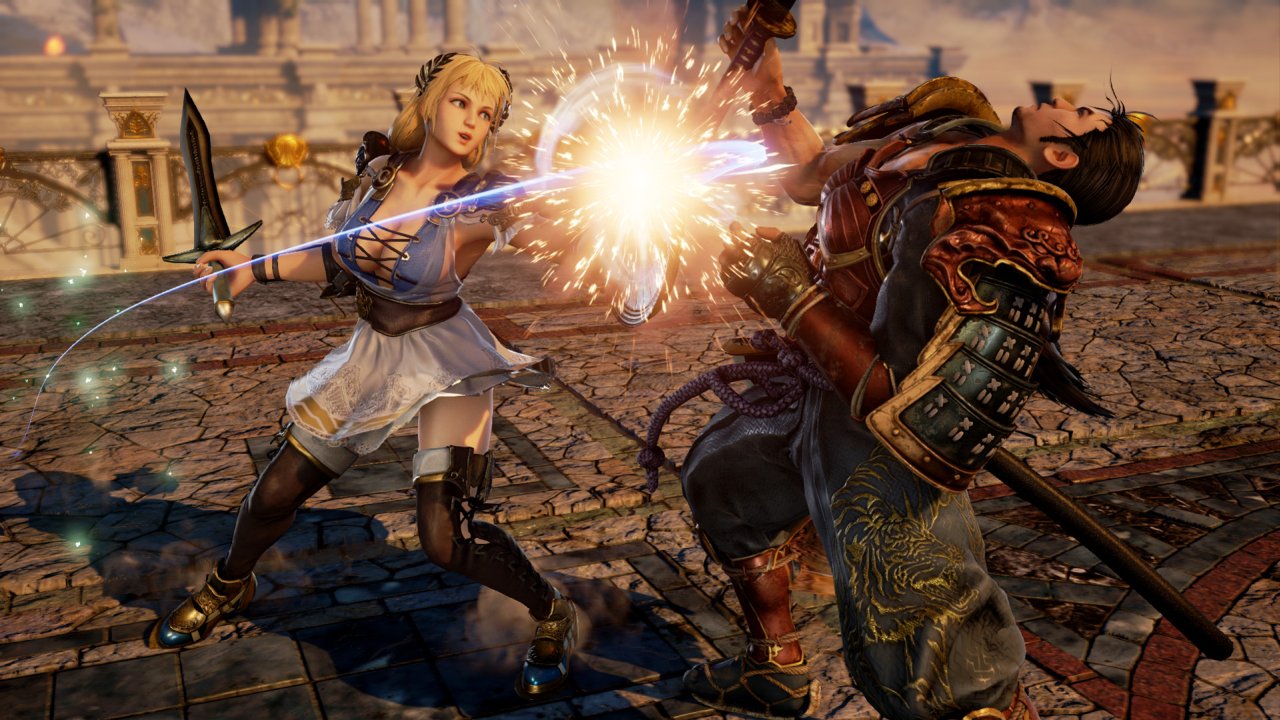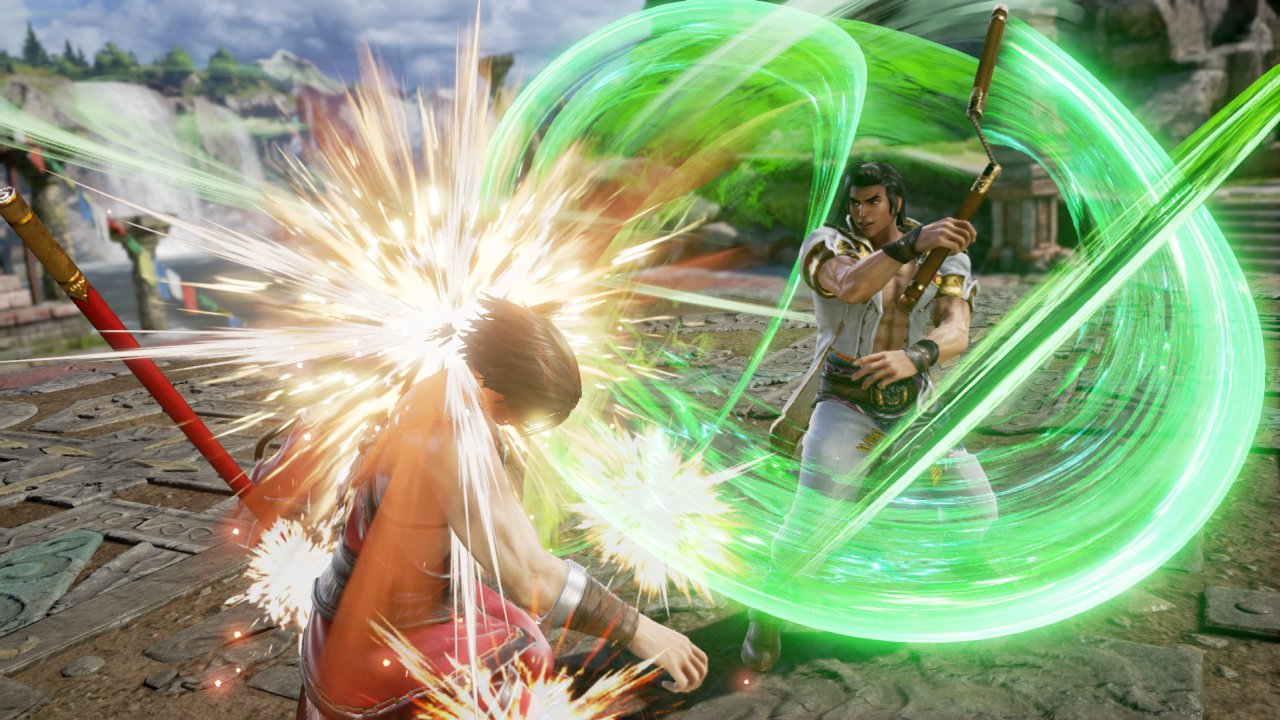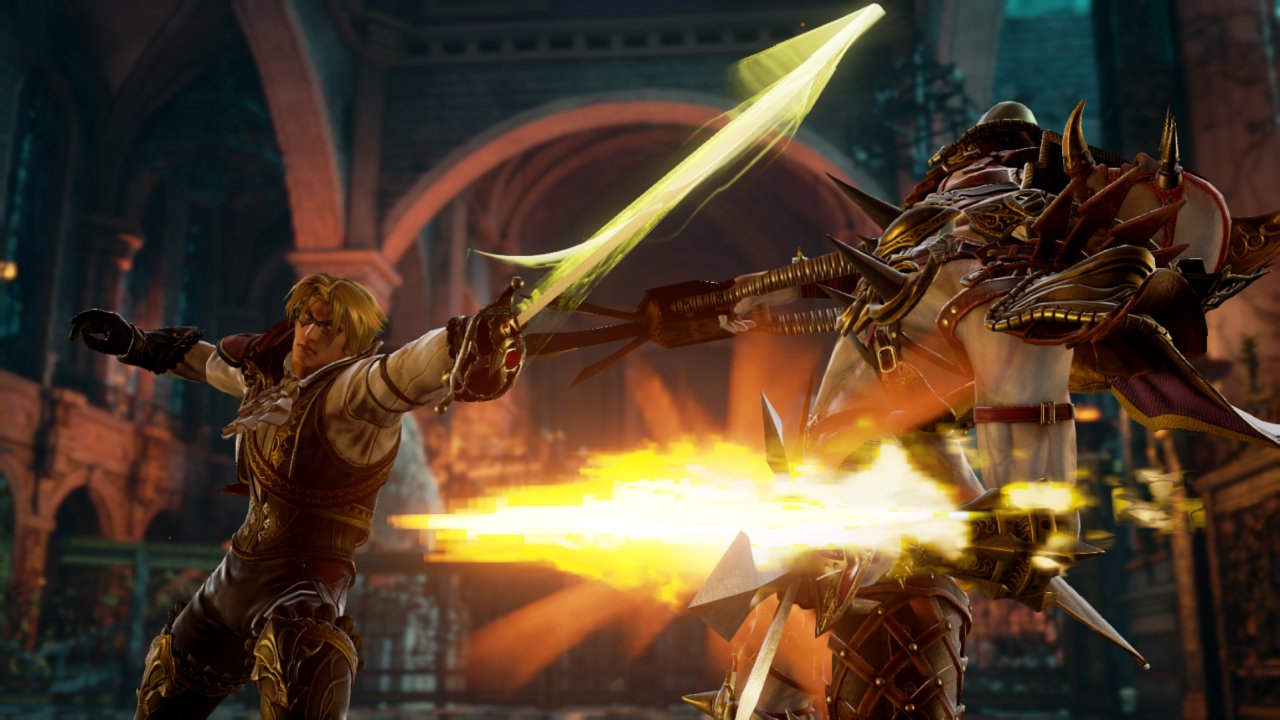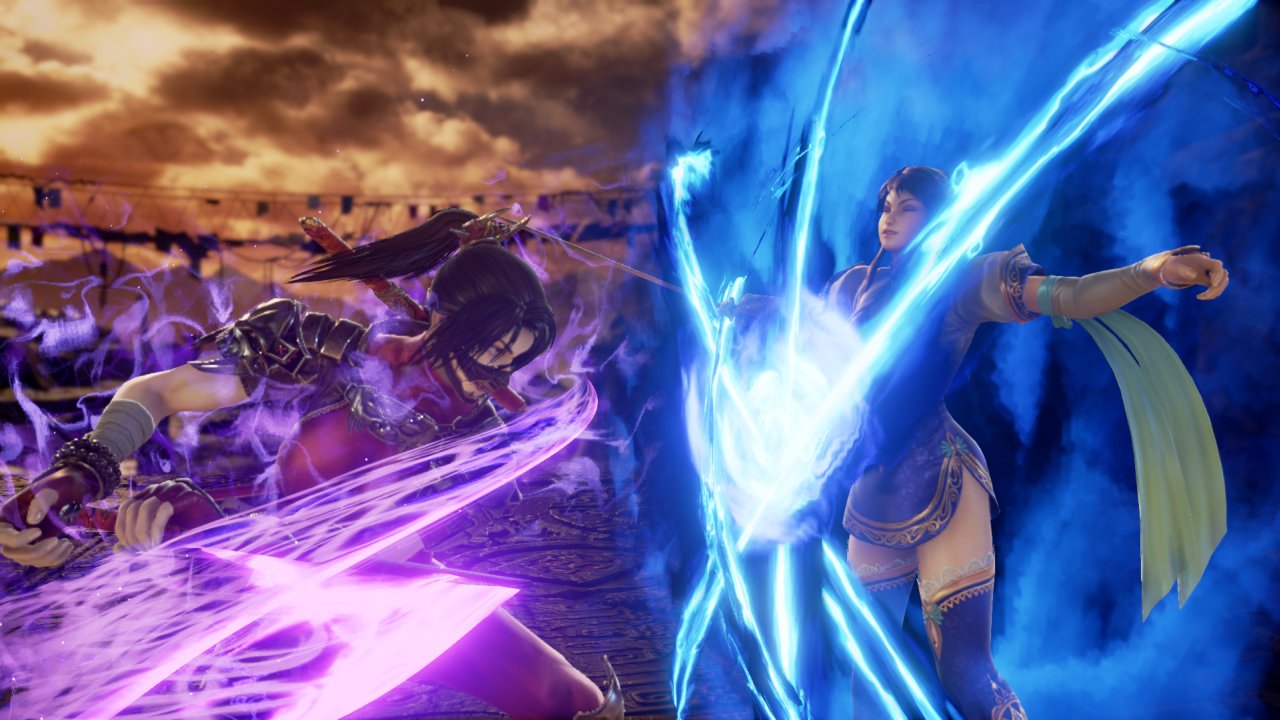Soulcalibur VI Review
A successful soft reboot for the unique fighting franchise
My first encounter with the Soulcalibur series was an arcade machine in a gym. What struck me was just how pretty it looked, not to mention it was a 3D fighter that focused on weapons combat instead of fists. Soulcalibur I became a mainstay of anyone’s Dreamcast experience, and I rediscovered the series with Soulcalibur II on Xbox. However, despite the enjoyment, the series dropped off my radar. That was until I played the Soulcalibur VI demo at E3 2018 and wanted more.

Soulcalibur VI is best considered a soft reboot of the series, going all the way back to the events of the first game. Taking place in the 16th century, the story follows the eponymous and evilly sentient blade Soul Edge and its counterpart Soul Calibur. There is a fair chunk of narrative concerning how each character in the roster interacts, covets, and is affected by the blades.
In battle, your face-button moves are divided into a horizontal, vertical, and kick attack. You can also block enemy attacks - both high and low. While that may seem familiar, what you need to take into account is SC VI’s eight-way movement system. Typically, in fighters, you’re used to sidestepping attacks, but not actively running/walking in a clockwise/counterclockwise direction. It’s one of the features that makes the game unique and forces you to change how you approach the battle itself. Over the years, it’s been ingrained in many fighters that, at the very least, you can block an attack, or lunge forward or backwards to avoid it. However, what SC VI does is make circling the environment just as valid (and oftentimes more important) a tactic than simply blocking, opening a new way to think about battle.
Soulcalibur VI also introduces the Reversal Edge. In essence, it’s a move that can cut through a foe’s move or guard, invoking a rock-paper-scissors-type standoff where you must tap one of your offensive buttons to attack your opponent. If you win, you’ll attack leaving them open, and vice versa. However, you can even choose to dodge their riposte completely, adding another dimension to the mechanic. While I did find it useful if you’re backed against a wall or just need some breathing room, AI opponents tended to spam the attack and human combatants hardly used it.
What did see more usage against both sets of foes was the Critical Edge first introduced in Soulcalibur V. Much like Street Fighter and Tekken (and others, I’m sure), you have a bar - Soul Gauge - consisting of 2 stages. These fill up as you battle and take damage. A Critical Edge is a powerful and flashy attack capable of shearing off a good portion of health. As you can imagine, these moves are perfect for finishing off a tricky opponent or evening the odds when you’re taking a beating, quickly changing the tide of battle. What you have to balance this bar with is the equally useful Soul Charge, allowing characters to transform into more powerful versions of themselves, which opens up new, deadly movesets. In the hands of good players, this can absolutely destroy opponents that were not expecting it.
What differentiates Soulcalibur VI, and the series in general, from its peers is still its weapons. The game demands you think differently to other fighters on the market and play to your character’s strengths, ensuring each character feels unique. I tended to gravitate to the likes of Yoshimitsu, guest character Geralt, Mitsuguri, and Taki - typically close-range fighters. This was because you aren’t faced with a slew of moves like Tekken or Dead or Alive, and moves generally follow similar executions, so it’s easy to pick up and play with others. While I usually have a phobia of characters with massive swords, axes, etc. because games typically make them play like they’re fighting through syrup, Soulcalibur gets the balance just right, not to mention making them powerhouses in the right hands.

New characters to the series include the aforementioned Geralt from The Witcher series, who wields his silver and regular swords; Azwel, who can conjure magical blades and has a really flashy moveset; and Groh, who sports a double-sided blade (think Darth Maul). Geralt is more for beginner players as his moves are simple yet effective, while Groh and Azwel take a little more thought to use effectively.
The stages have also been one of the focal points of the series. On the sliding scale, Street Fighter is the classic 2D arena; more recent Tekken and Dead or Alive let you knock opponents through various parts of stages; and SC VI allows you to whack foes clean out of the ring for an instant KO. This mechanic adds an extra level of cautiousness to matches, as in addition to avoiding your opponent, you also have to be wary of just how far you’re skirting a ring out. It’s also extremely satisfying to lure your opponent towards the edge or time a dodge just right and send them flying.
The stages are all beautifully realized and one of the series’ most striking features. Geralt has his Kaer Morhen stage, and you’ll fight on blocky desert platforms, windswept plains, murky swamps, and in astral dimensions. However, all that beauty in the environments didn’t quite transfer to the characters themselves. While they do all have a unique appearance and are excellently designed, I don’t think they use the Unreal Engine 4 as well as Tekken 7, as far as character models are concerned.
Taking a step back from SC VI’s raw mechanics, there are numerous ways you can find a fight. As you’d expect, there’s a basic Arcade mode consisting of eight stages that culminate in fighting Geralt. You can choose from several difficulties and it has a time attack element built in, though is nothing special. Of course, there is a Versus mode, but not a hint of Survival, Team Battling, or anything out of the ordinary.
Training mode is where Soulcalibur VI makes some of its most glaring errors. First off, when you pick a character to train with, it’s quite obvious you want to learn their moves. Way back around the PlayStation-era, this meant bringing up a menu every time you want to view a move, perform it, then bring up the menu again, etc. Painful and slow. Games have moved on, and nearly every fighting game now will allow you to bring up the menu, perform a move correctly, then move onto the next. For some reason, SC VI does not do this, and it is such a basic error in helping both new and old players learn moves.
Another issue that appeared for me in training was just how the game chooses to convey information about best moves for certain characters. You can click on a character name via the menu, and lengthy paragraphs about them pop up, explaining tactics. It’s just a very strange way to display this information and is not at all appealing. Not to mention the poor job it does by practically explaining new mechanics by hiding them in another mode altogether.
These may seem like minor points to some, but to me it’s just such a poor way of helping new players into the game. If they can’t easily learn moves, they’ll just use the basic ones they come across, become bored, and leave the game. In my case, I had to grab my laptop and bring up the move-sheets for characters I wanted to learn.

However, if you do manage to get comfortable with a character and want a little more than what Arcade mode has to offer, there are two modes available: Soul Chronicle and Libra of Soul. Soul Chronicle is a retelling of the events from the first game. You can choose a general and literal timeline that spans across several years, where you’ll learn about the blades. In addition, you will also take the roles of different characters along the way, starting with Kilik, then Maxi, and more as time progresses.
You can also choose to delve into individual story timelines for every character. These occur at different points, and last for a different number of battles depending on who you choose. Unlike Arcade mode, where you face off against characters from the main roster, the majority of foes in Soul Chronicle are modified skins of characters with generic names or those that pertain to the relevant timeline.
It’s an interesting divergence for usual Story Modes in fighting games, which tended to be cutscenes in between regular Arcade. Battles don’t last long, and you sometimes battle several enemies in succession. It allows you to learn more about individual character motivations and how they fit in the story. To me, at least, the stories themselves aren’t the most thrilling - more like little visual novels - but I’m glad the effort was included. Another neat point in Soul Chronicle is that it is impacted by the aforementioned Libra of Soul.
Libra of Soul is a mode in which you create your own character to experience the tale of Soulcalibur from a unique perspective. The character creation mode is a whole other facet of SC VI in itself, but the general gist is that you can play about with a character’s features and equipment, finally choosing a fighting style for them based off the other heroes in the game. When your character is created, you’re thrown onto a 16th century world map. The crux of Libra of Soul is that you have some mysterious connection to Soul Edge, and embark on a quest to stop some big evil from collecting all of its shards. Along your journey, you can also make binary choices that impact your learning towards Edge or Calibur.
One important and baffling point to note about Libra of Soul is that this is where the game chooses to practically explain its Reversal Edge system in a series of tutorial missions. While I was grateful for this, the fact it was here and not also accessible in the training menu was absurd.
I quite liked Libra of Soul as it does a few things other fighting games could learn from. Your ability to roam around the world map, travelling from dot to dot to complete quests, level up, meet and recruit characters from the series, as well as shop for new weapons, compounds for an enjoyable package. You can earn money to buy said items, as well as use it to recruit mercenaries that can be sent on quests. Another cool facet is that, at times, the characters you choose to let join your posse or the quests you take can open up new quest lines and seal off others, lending itself to replayability. If and when you encounter game characters, it opens up their “Hidden Records” in Soul Chronicles, explaining how/when they met your created character.
Libra of Soul is also a perfect place to get to know fighting styles better. Because you can change weapons on the fly, you’re not stuck with any one style. This helped tremendously when I’d been in training, learnt the basics of character, then went to the mode and fine tuned my tactics before heading online.

Soulcalibur VI’s character creation/modification mode also deserves a shout out. You can build a character from scratch (though can’t use them in Libra of Soul, which has its own creator system), modifying their features, skin colour, clothes, as well as their fighting style. While the number of items does not quite rival the likes of, say, Tekken, they are certainly flamboyant and the community has created some awesome designs of well-known characters. The ability to modify existing characters is also a important factor these days, especially when you’re online and want to distinguish yourself.
After creating or modifying a character, and mastering their moves, you may want to try your hand bashing human opponents. SC VI does this in the form of casual and ranked battles. The former does not impact your ranking and lets you enter a “room” of varying sizes, where there is a winner-stays-on mode. As you can imagine, if you’re constantly thrashing people, then you’ll be playing a match every couple of minutes or so. If you’re doomed to keep losing, then you may be waiting a while for the next match. However, the ability to watch each match unfold as a spectator is great way to learn play tactics that help you fight and read opponents better.
The ultimate challenge, however, is putting your rank on the line in an attempt to level up. If you’ve played any fighter online, it’s what you’d expect. You can choose the range of skill ranks you want to face, their connection, location, and a few other minor details. The amount of time it takes to connect varied in my time playing. Sometimes I went into a match within seconds, other times I waited for minutes (with all settings open) and more often than not faced a high-level opponent. The positive from that is that there were very few instances of lag, and I’d prefer a longer wait time to secure the best connection.
Online is the most thrilling mode in SC VI, simply because it’s the greatest test of skill. And, boy, there are some skillful players out there. If you’re a beginner, it may be easy to get disheartened. But, like any game, the more you play and learn, the better you become, which Soulcalibur rewards. I think my critique of online modes is that you can’t employ some of the interesting battle modifications found in Libra of Soul, even if it were just for casual matches.
Ultimately, Soulcalibur VI is not only an excellent continuation of the series but a fine contender to mainstays of the competitive fighting game scene. A number of mechanics unique to the series, including its weapons-based combat, make for a diverse roster of characters, all of which are easy to pick up and start battling with. However, the game fumbles in its most basic educational areas and somewhat baffling methods it uses to deliver new and tactical information.
 Comments
Comments




















